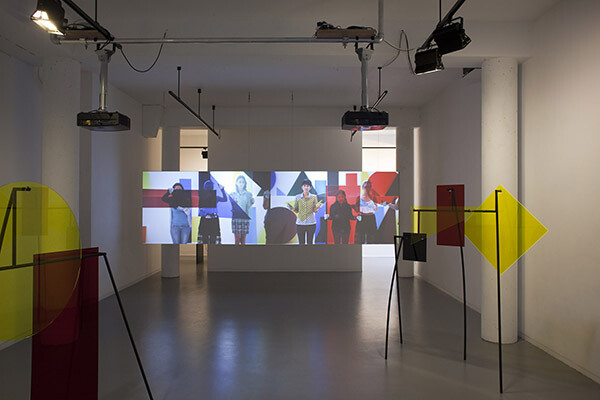Twenty-first century communication has dramatically changed the way information reaches us. Popular interpretations of knowledge and history seem to do so without historical consciousness and self-reflexivity. Rather than playing with the structure of history, Amalia Pica, in her solo show at Stigter van Doesburg, “One Thing after Another,” concerns herself with the underpinning structure of the structure. She rejects the finality of the object or image, and broadens it from a singular, formal focus to a multifaceted perspective.
The exhibition is a continuation of a project that the London-based Argentinian artist began at the Museo Tamayo in Mexico City in the summer of 2013. Next to some colorful Plexiglas sculptures and pastel-colored prints in the smaller rooms, the show’s focal point is the large installation A∩B∩C∩A∩B∩C (2014), which consists of two Plexiglas sculptures and a two-channel video projection. The sculptures, entitled Maremila and Remoromi (both 2014), are a variety of metal structures holding colored geometrical shapes in saturated blue, red, and yellow. They further Pica’s research on the Venn diagram and the set theory it illustrates, which describes the logical, mathematical relationships of inclusion and exclusion, developed by logician and philosopher John Venn (1834–1923). Under the 1976–1983 military dictatorship in Argentina, the Venn diagram’s intersecting and overlapping circles were banned from primary school curricula, according to the artist because they were feared to encourage subversive models of collectivity.
The two-channel projection screens documentation of performances that were executed at Pica’s show in Mexico City, created with Mexican filmmaker Rafael Ortega. Performers are seen to repeatedly bring the Plexiglas circles, squares, and triangles from the gallery walls to the middle of the space, using them as compositional pieces to build new configurations. This is, however, only gradually disclosed throughout the video; there are moments when both screens intersect, and sometimes even form a singular image, creating a storyline that travels from extremely abstract (zoomed in on the geometric shapes) to figurative as the performers steadily become more visible. A soundtrack of voices speaking in a non-language accompanies the work. Words are seemingly spelled out but in fact carry no terminology or significance at all. This is what seems to drive Pica’s work: the question of how data and knowledge reach us through certain filters and the inescapably political nature of information exchange. With access to new resources created by the digitization of historical archives over the last decade, artists are increasingly able to give special consideration to the significant acts of classification, use, evaluation, and interpretation of information in artistic thought. How does this effectuate a relation with history, information, and data that provides room for categories that can be repeatedly reinterpreted?
Snapshots in time, the sculptures are the result of the varied compositional proposals made by the performers in the video. Supplementary to the original, their absence is given a shape. Apart from their formal explorations of minimalism and Kinetic Art, the work above all else functions on several levels of seeming oppositions: inside and outside; sculpture and architecture; work and viewer. All contribute to revealing the syntheses of history, continuation, language, and composition.
In “One Thing after Another,” Pica taps into the discussion about contemporary art’s movement away from representation of the image and production of the object into the creation and documentation of situations which can be experienced and reconstructed.
The plain, colorful, semi-transparent sculptural elements offer a minimal yet seductive aesthetic, with which Pica attempts to lay bare the contradictions of master narratives, and thus the invention of counter-narratives. One of the implicit intentions underlying much of this activity is to engage the viewer as an active participant by encouraging her to piece elements together, fill in gaps, and enter into the scenario as a protagonist, thus shifting his position from that of the image’s beholder to its interpreter.










